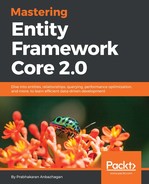The dependency injection support in the ASP.NET framework came too late for the .NET developers/architects who were seeking shelter from third-party tools such as Ninject, StructureMap, Castle Windsor, and so on. Finally, we gained support from ASP.NET Core. It has most of the features from the third-party DI providers, but the only difference is the configuration should happen inside the Startup.cs middleware.
First thing's first, let's configure the connection string in our new appSettings.json:
"ConnectionStrings": {
"DefaultConnection": "Server
(localdb)\mssqllocaldb;Database=MasteringEFCoreBlog;
Trusted_Connection=True;MultipleActiveResultSets=true"
},
Then configure the context as a service (all service configuration goes into Startup.cs). To support that, import MasteringEFCore.Web.Data and Microsoft.EntityFrameworkCore in the Startup class. Finally, add the DbContext to the services collection by creating and including DbContextOptionsBuilder using UseSqlServer():
public void ConfigureServices(IServiceCollection services)
{
// Add framework services.
services.AddDbContext<BlogContext>(options =>
options.UseSqlServer(Configuration.GetConnectionString("
DefaultConnection")));
services.AddMvc();
}
We have configured the database context using dependency injection, and at this stage, we are good to go. We are almost there. As of now, we have the schema required for the database and the context for EF and services being configured. All of these will end up providing an empty database with literally no values in it. Run the application and see that an empty database is created. It will be of no use. In the next section, let's see how we can seed the database with master data/create tables with sample data, which can be consumed by the application.
